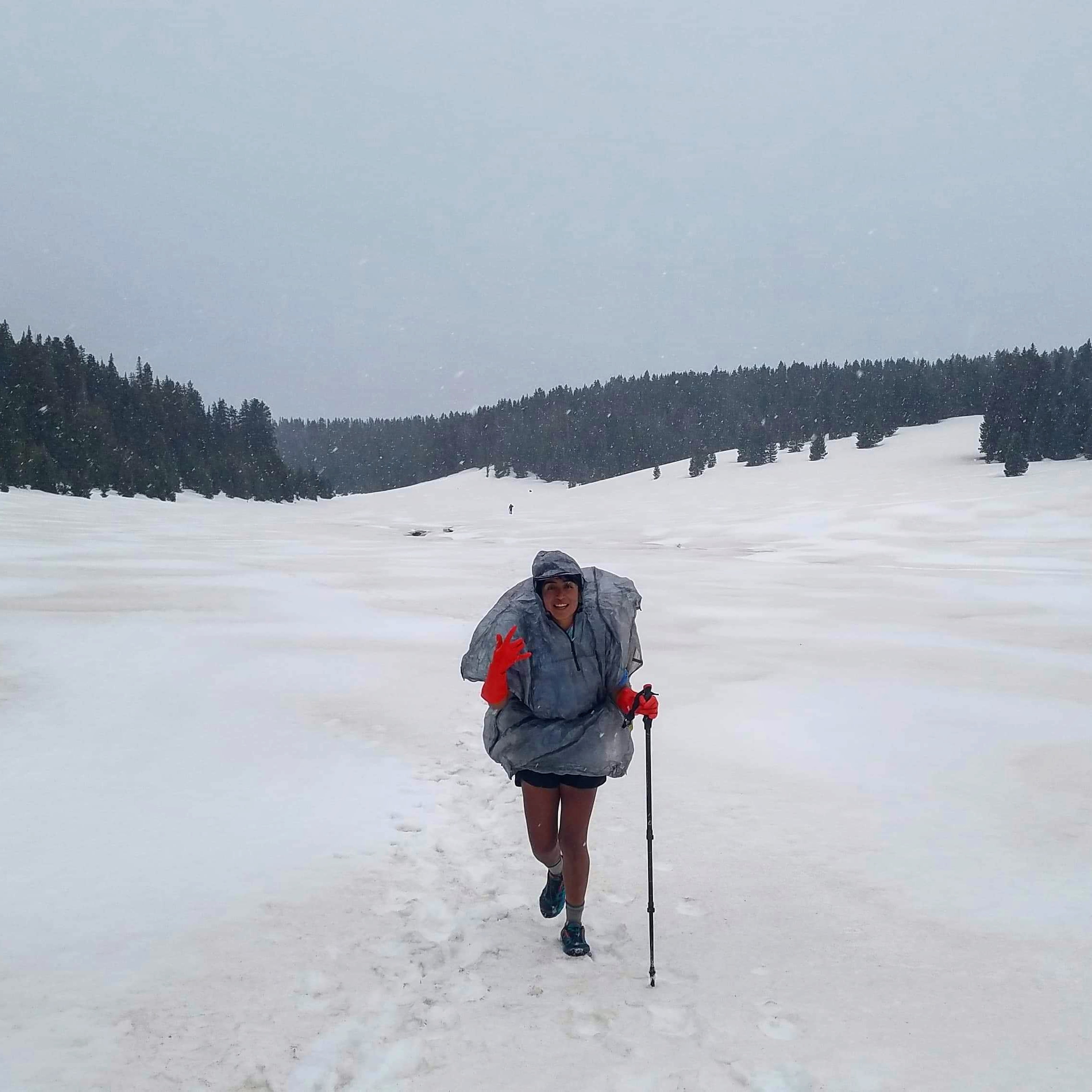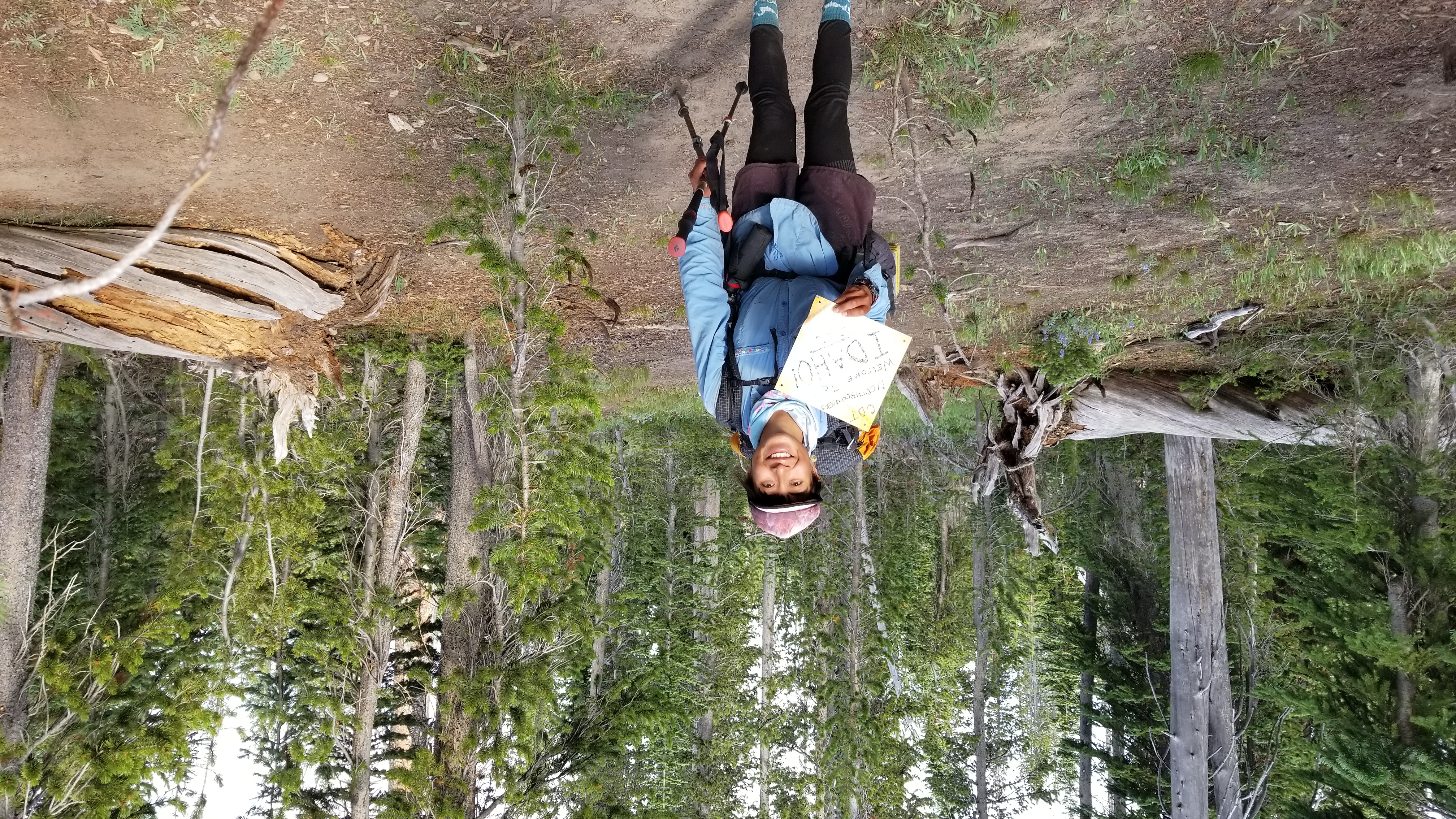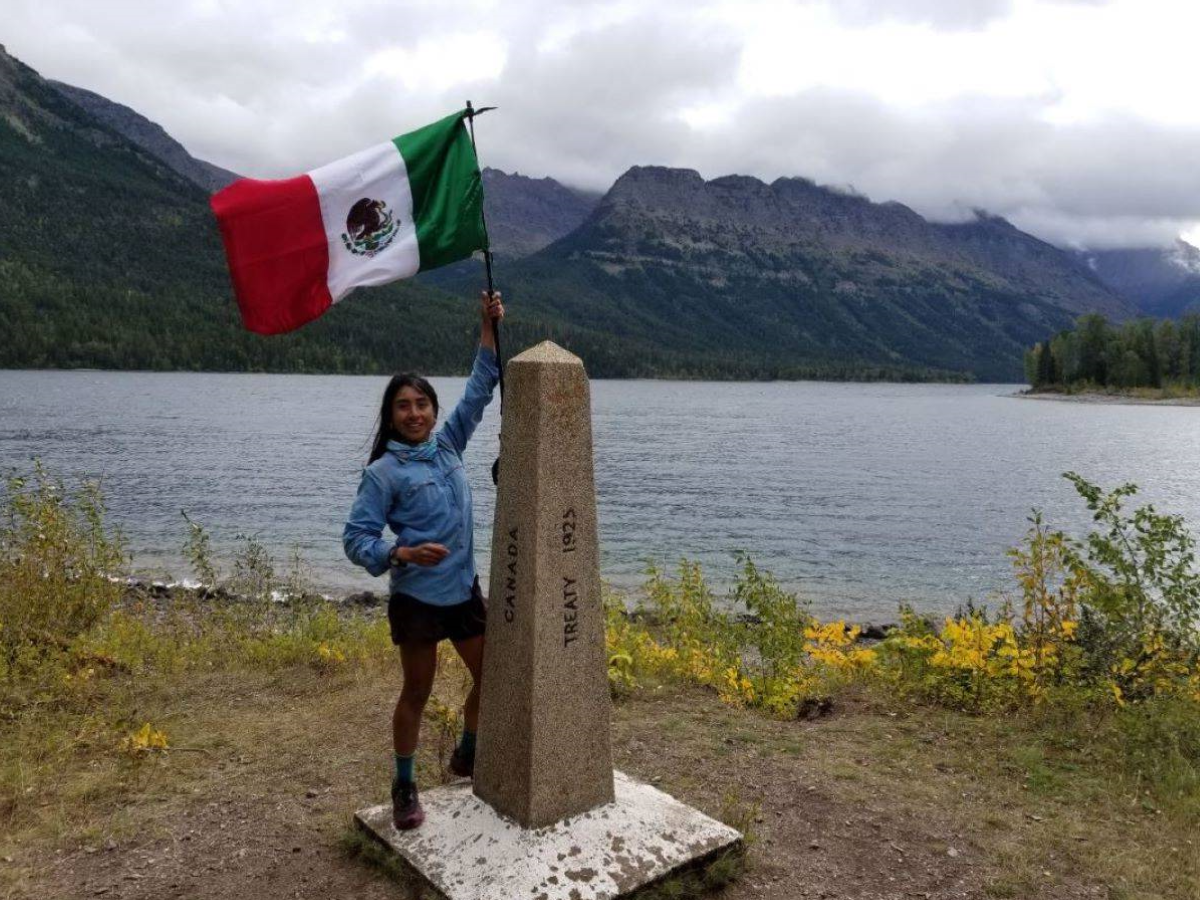¿Qué es la pasión? ¿Qué es sentirla? El diccionario define a la palabra pasión con varios significados, pero es esta descripción, apetito de algo o afición vehemente a ello, la que mejor describe lo que siente Zelzin Aketzalli por el senderismo de larga distancia.
Nacida en Ciudad de México hace 28 años, y conocida en el mundo del senderismo como “Quetzal”, Zelzin es la única persona mexicana en haber completado los tres senderos de larga distancia más importantes de los Estados Unidos, lo que se conoce como el Triple Crown. Lee su entrevista y entérate cómo nació su pasión por el senderismo de larga distancia (thru-hiking), los retos encontrados en el camino y cuáles son sus metas en este campo. Conoce a Zelzin y cómo la conservación de nuestro planeta cada día depende más de personas como ella.
¿Qué te motivó a empezar a practicar el senderismo de larga distancia en modo thru-hiking?
Desde pequeña practicaba deportes de alto rendimiento, en la preparatoria pasé a formar parte del equipo de remo de la escuela donde estudiaba. En ese período comencé a practicar el mountain biking, pero al ser un mundo dominado por hombres y yo sabía que la mejor manera de mejorar mi rendimiento en el ciclismo de montaña era comenzar a practicar en veredas que yo recordaba mientras competía en ese deporte. Fue mágico como en mi mente quedaban grabadas las mismas. Antes de graduarme de la universidad como ingeniera ya tenía un trabajo esperándome pero sabía que me quería hacer un gran regalo previo a empezar mi vida laboral y quería hacer algo diferente, así que pensé hacer una trayectoria en bicicleta desde México hasta la Patagonia. Luego de unos meses de práctica supe que eso no era para mí pero no me detuve en mi búsqueda de una gran aventura, me puse a investigar y ahí fue como supe del Pacific Crest Trail, no lo pensé dos veces y tomé la decisión de caminarlo por completo en solitario en modo thru-hiking.
Al ser una mujer Latina ¿cómo ha sido la reacción de la comunidad de senderistas?
Lo primero que tengo que decir respecto a eso es lo maravillada que quedé cuando llegué a los Estados Unidos para caminar el Pacific Crest Trail y vi tantas mujeres. Fue increíble, fue una gran inspiración para mí ver mujeres de todas las edades solas, era como un paraíso verlas viviendo en la montaña. A veces yo en México lo hacía sola o con hombres, pero acá no era la única. Sí vi muy pocos Latinos, tal vez unos cinco, pero la gente se sorprendía cuando les decía que era de México, me decían “wao nunca habíamos visto a nadie de México en este camino”, me hacían fiesta y eso me hizo sentir muy orgullosa de representar a mi país. No voy a mentir, al principio de esa aventura sentí un poco de miedo, era la época de Trump, yo no hablaba inglés y cuando me preguntaban de donde era siempre lo decía bajito pero la mentalidad de las personas que practican el senderismo es muy diferente, me sentí parte de una nueva familia, mi familia del sendero.
 Zelzin Aketzalli
Zelzin Aketzalli
En tu práctica de senderismo ¿qué haces para crear conciencia sobre el medio ambiente?
Soy minimalista en cuanto a lo que llevo, primero por el peso, camino con todo arriba. Y luego porque hay muchas cosas que no son necesarias, y eso lo digo mucho en los cursos que enseño sobre thru-hiking. Llevar lo mínimo para no crear desperdicios innecesarios, por ejemplo si llevo cosas de comer las acomodo de tal manera que no tenga que llevarme sus empaques. En mi mochila solo llevo lo necesario, se ha vuelto en un estilo de vida. Como mexicana ya venía con una cultura de reciclar, comer lo más natural posible, hacer composta, conservar el agua. Muchos lo hacemos porque nos criamos en el campo, yo esa manera de pensar se la debo a mi mamá.
Habiendo dicho eso ¿de dónde crees que nos viene a los Latinos esta cultura de proteger al planeta?
De nuestros antepasados, pero nos falta mucho por ser como ellos. Hay muchos que no les importa, creo que la parte de conservar nos viene más por el lado agrícola, el respeto por la tierra. Por ejemplo, los aztecas le hacían mucho tributo a Tonantzin, la diosa de la Madre Tierra.
¿Qué piensas se puede hacer para involucrar más a los Latinos en la conservación del medio ambiente?
Empezar a educar, es lo más importante. Y no hablo de solo decirles “tienes que hacer esto”, no. Hablo de llevarlos a que vean esos espacios hermosos, que conozcan la naturaleza y se enamoren, esa es la mejor manera de generar respeto con amor.
¿Cómo nació la iniciativa de enseñar cursos de senderismo?
Cuando llegué a Estados Unidos a caminar el Pacific Crest Trail no sabía nada de conservación, ni de senderismo. Cuando vi lo organizado que estaba quise aprender sobre todo. Entonces empecé hablando sobre lo que es el thru hiking, decidí que quería hablar sobre este tipo de senderismo cuando estaba caminando el Pacific Crest Trail y tomé la decisión de hacer el “Triple Crown”. Quería que la gente en México supiera lo que es y cómo se hace. Quería que supieran que los senderos son para todos, son espacios abiertos, puede ir el que quiera.
 Zelzin Aketzalli. Wyoming
Zelzin Aketzalli. Wyoming
¿Cuáles son tus metas en el campo del senderismo?
La meta más importante ahora mismo es poder ver a más personas de Latinoamérica haciendo “thru-hiking” y la segunda es crear en México un sendero, como el Pacific Crest Trail, donde todo está identificado y rotulado. Pero creo que algo muy importante antes de crear ese sendero es la educación, que las personas aprendan a cómo conservar ese espacio. Para mí sería muy triste que las personas fueran a ese sendero y no lo cuidaran.
Aquí datos adicionales sobre Zelzin, también puedes seguirla en Instagram @zelzin_aketzalli
Hiking (senderismo)
Hacer un sendero de larga distancia de principio a fin en pasos continuos sé llama THRU-HIKING. ¡Todo el recorrido es caminando y por la montaña!
Senderos de larga distancia que Zelzin ha caminado:
2017 Pacific Crest Trail 2658 millas (4278 km), 153 días en total.
2018 Hayduke Trail 836 millas (1345 km), 60 días en total.
2018 Appalachian Trail 2190 millas (3524 km), 100 dias en total.
2019 Continental Divide Trail 3018 millas (4857 km), 145 días en total.
2020 The Great Western Loop Challenge evento cancelado por COVID-19, 767 millas (1234 km) de 7000 millas (11265 km), 53 dias
2020 Arizona Trail 800 millas (1287 km) 37 dias
Cuando logró la Triple Crown solo habían 440 personas en el mundo que lo habían completado. Es la única persona mexicana, hasta ahora, en lograrlo.
Total de kilómetros acumulados = 16,526 km (10,269 millas)
What is passion? What is it to feel it? The dictionary offers many definitions, but the description of it as an “appetite for something or vehement fondness for it,” is what best describes how Zelzin Aketzali feels about hiking.
Born in Mexico City 28 years ago, and known in the hiking world as “Quetzal,” Zelzin is the only Mexican person to have completed the three most important long-distance trails in the United States, known as the Triple Crown. Read our interview with her to learn how her passion for long-distance hiking, or thru-hiking, was born, her goals in the field, and the challenges she’s encountered in pursuing them. Meet Zelzin, and find out why the conservation of our planet depends on people like her.
What motivated you to start long-distance hiking?
Since I was little I practiced high-performance sports. In vocational school, I became part of the rowing team. In that period I started to practice mountain biking. The sport was dominated by men, and I wanted to compete at the same level, so I practiced constantly and used trails to improve my cycling performance. Later, I stopped practicing that sport, but those trails were forever etched in my mind. Before I graduated from university I already had a job waiting for me, but I knew I wanted to give myself a great gift before I started my working life, and I knew I wanted to do something different. So I decided to do a bike ride from Mexico to Patagonia. After a few months of practice I knew that that journey wasn’t for me, but I was looking for an adventure anyway. I started to investigate and that's how I found out about the Pacific Crest Trail.
How did the hiking community react to you as a Latina woman?
The first thing I have to say about that is how amazed I was when I came to the United States to hike the Pacific Crest Trail and saw so many women. It w was a great inspiration for me to see women of all ages alone, it was like a paradise to see them living in the mountains. Sometimes in Mexico I hiked alone or with men, but here I wasn't the only one. I did see very few Latinos, maybe five, and people were surprised when I told them I was from Mexico. They told me “Wow, we've never seen anyone from Mexico on this trail.” They threw me a party to welcome me and that made me feel very proud of being able to represent my country. I'm not going to lie, at the beginning of that adventure I felt a little scared. It was the Trump era and I didn't speak English. When people asked me where I was from I always said it softly. But the mentality of people who go hiking is very different. I felt accepted.
How do you embrace sustainability in your hiking practice?
I am minimalist in terms of what I wear, first because of the weight, I walk with everything on my back. I also do it to reduce waste, and I tell my students to do the same in the courses I teach about thru-hiking. For example if I bring things to eat, I arrange them in such a way that I do not have to take their packaging with me. In my backpack I only carry what is necessary; it has become a lifestyle. As a Mexican, I came from a culture of recycling, eating as natural as possible, composting, and conserving water. Many of us do it because we grew up in the countryside. I also owe that way of thinking to my mom.
Having said that, where do you think this culture of protecting the planet comes from?
From our ancestors, but we still have a long way to go to be like them. There are many people who do not care about protecting the planet. I think that the part of conservation comes more from the agricultural side, respect for the land. For example, the Aztecs paid a lot of tribute to Tonantzin, the goddess of mother earth.
What do you think can be done to get Latinos more involved in environmental conservation?
Start with education. It's the most important thing. And I'm not talking about just telling people “You have to do this.” I'm talking about taking them to see those beautiful spaces, to get to know nature.
How did you decide to teach hiking classes?
When I came to the United States to walk the Pacific Crest Trail, I knew nothing about conservation or hiking.When I saw how organized hiking was, I wanted to learn all about it. So I started talking about what thru-hiking is. I decided that I wanted to talk about this type of hiking when I was walking the Pacific Crest Trail and I made the decision to do the “Triple Crown.” I wanted people in Mexico to know what it is and how it's done. I wanted them to know that the trails are for everyone, that they are open spaces for anyone who wants to go.
What are your goals in the field of thru-hiking?
The most important goal right now is to be able to see more people from Latin America doing thru-hiking, and the second is to create a trail in Mexico, like the Pacific Crest Trail, where everything is identified and labeled. But it would be important to educate people about how to take care of it before it was built. It would be very sad to me if people went to that trail and didn't take care of it.
Here is some additional information about Zelzin. You can also follow her on Instagram @zelzin_aketzalli.
Long-distance trails she has walked:
2017 Pacific Crest Trail 2658 miles (4,278 kilometers [km]), 153 days total.
2018 Hayduke Trail 836 miles (1,345 km), 60 days total.
2018 Appalachian Trail 2190 miles (3,524 km), 100 days in total.
2019 Continental Divide Trail 3018 miles (4,857 km), 145 days total.
2020 The Great Western Loop Challenge event canceled due to COVID-19, 767 miles (1,234 km) of 7,000 miles (11,265 km), 53 days.
2020 Arizona Trail 800 miles (1287 km) 37 days.
Total accumulated kilometers = 16,526 km (10,269 miles)
When she achieved the Triple Crown, she was one of only 440 people in the world to have completed it, and the only Mexican person, so far, to achieve it.
